Chapter 9. EVERYTHING I LEARNED ABOUT LEVEL DESIGN, I LEARNED FROM LEVEL 9
You can't expect a book called Level Up! not to have a chapter on level design. But what do I mean by level? Much like the word score[98], its definition changes when used in different contexts. Observe:
Level: an environment or location where game play occurs. "If you are on the Death Star level then you are near the end of the game."
And
Level: a term favored by developers that describes how to break up physical space based on a specific gameplay experience. "I must have died a dozen times on the mine cart level."
And
Level: a unit of counting the player's progression, especially, when repetitive gameplay is involved. "I'm up to level 20 on Tetris."
And
Level: the rank of a player based on their earned score, experience, or skills. A term for marking character progression and improvement as in: "I finally leveled up my third WoW character to 70." The most common use of level in this context can be found in RPGs.
A possible explanation for level having four definitions in the video game industry is that video game developers have extremely limited vocabularies.
Another reason for the multiple definitions is that developers have used the term "level" in different contexts for so long that it's too late to get everyone to agree to call it something else like a floobit or a placenheimer. So level it is. But why level? Most ancient game designers believe that the term came from Dungeons and Dragons, when players would travel down many dungeon levels (like floors of a building) to reach the dragon. (Hence the title of the game.) Why no one thought to call it "floors" is beyond me.
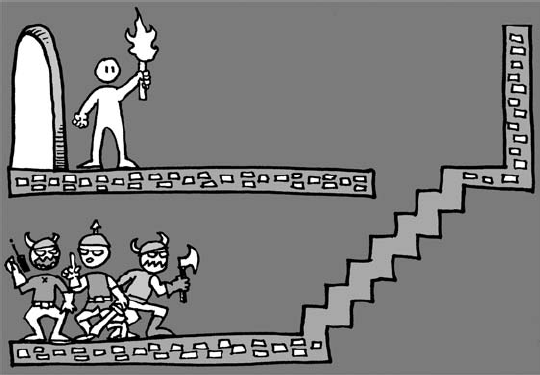
In fact, to complicate things further, there are many times a level isn't even called a level. I've played games with rounds, waves, stages, acts, chapters, maps, and worlds in place of where I would use the term level, but even these have their specific definitions. Let's review:
Rounds can be found in games where you play the same action, if not similar gameplay, over and over again. It can be used for sports games like a round of golf or boxing where the activity is the same, or there can be variation in the gameplay like rounds of Peggle or Diner Dash.
Waves usually refers to combat, as in "wave after wave of enemies assaulted the stalwart heroes!" Pretty exciting stuff, but you are still doing the same thing—beating[99] the crap out of bad guys. Whole games can be made of waves of enemies like in Plants vs. Zombies and Defend my Castle, or it can be a sequence of play like those found in Gears of War 2 or Uncharted 2[100].
Stage is usually interchangeable with the term wave, but it's often used when describing an experience that has clear separations that relate to the activity—much like the separate stages of a rocket[101]. Stage is often used when referring to the actions of a boss enemy. We'll talk more about this later in the dreaded Level 13.
Acts and chapters are often used when the developer wants the player to concentrate on the story of the game. These titles make a game feel classier. They're not fooling anyone; they're really just game levels.
Levels are often referred to as maps or by the location of the environment (like "Power Plant" or "Insane Asylum"). This is most common in FPSs, where players associate the location with a style or method of gameplay.
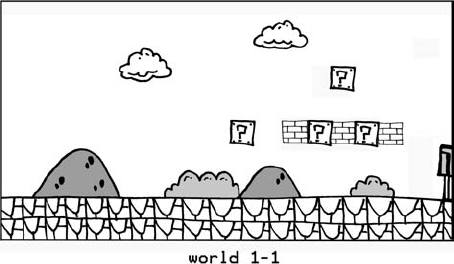
The term world is often confused with level, but I blame this on its origin. World was first used in Super Mario Bros. with the famous "World 1-1." The game was extremely successful and the term became immediately embraced by developers. However, by my own definition, World 1-1 should actually be called Level 1-1. And here's why:
World: a video game location that is distinguished primarily by its visual or genre theme and may be comprised of multiple locations that share this theme.
In early video games, players would refer to the levels as worlds; as in "Fire World", "Ice World", and so on. However, as the home market demanded longer play experiences and developers wisely learned to create multiple levels using the same texture sets and/or mechanics, worlds gained additional sequences—most famously seen in Super Mario Bros.'s World 1-1. However, World 1-1 is just the first of four levels of the first world[102]. There needed to be a term to define these separate sections of play, hence the term level.
Because there have been so many game worlds over the years, some of them have become hoary clichés. Most developers run screaming from these, but they still have their uses. I therefore present to you:
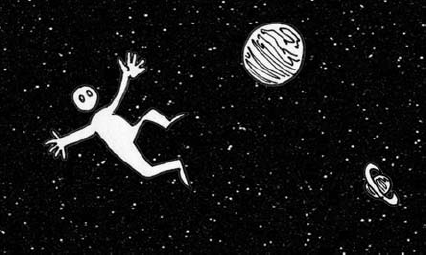
Outer space. One can easily see how a black television screen may have served as inspiration to early game developers as the perfect stand-in for outer space. Brightly displayed vector-drawn stars looked great on those early CRT screens. Player-controlled spaceships meant no animations. Spaceships could be rendered in simple geometric shapes. Gameplay could be based primarily on physics: an important advantage to those early programmers during the days prior to game designers and artists. As the earliest game genre—the shooter—evolved, outer space continued to be a popular locale for video game battles to be waged. Outer space also allows for all the tropes of sci-fi: aliens, spaceships, computers, and futuristic weapons. All things beloved by the geeky game developer community.
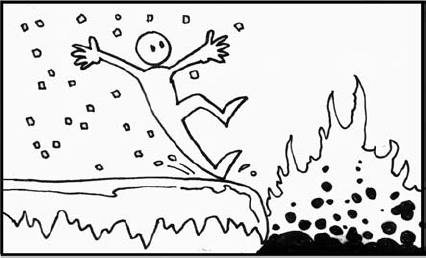
Fire/ice. These levels swiftly became popular for three reasons: first, fire and ice levels created hazards that were easy to program—flames and low friction surfaces. These hazardous terrains created perfect timing puzzles that caused the players to "break their rhythm", making the level more challenging. Secondly, fire and ice environments lent themselves towards a wide array of deadly inhabitants, from lava men and flame-breathing dragons to snowmen both of the abominable and frosty varieties. And third, fire and ice levels added color (red and blue) to the palette of gameplay worlds, especially important to distinguish screenshots on the back of home console boxes in those early 8-bit days. Today, fire and ice levels are camouflaged as snow-bound train wrecks and lava-filled temples, but as long as the color, feel and mechanics are represented, they'll always be fire and ice levels to me.
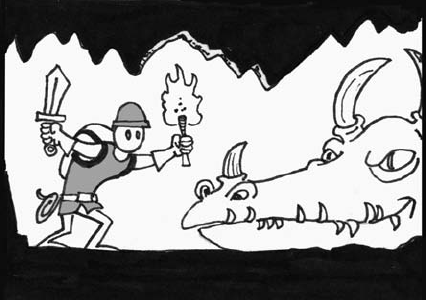
Dungeon/cavern/tomb. The connections between Dungeons and Dragons and Tolkien's Middle Earth run strong and deep in the DNA of video game developers. Dungeons are laden with traps to avoid, puzzles to solve, and mechanics to circumvent. Dungeons offer up waves of enemies (without a whiff of explanation as to why they live there) and of course, there was always lots of collectable treasure to be gleaned. Even when the game world isn't themed to medieval fantasy, players still thrill in raiding uncharted dusty tombs. Technically, dungeon locations offer game artists many advantages: great opportunities for dramatic lighting, and intricate carvings and statues. Even in the early days of gaming, cave wall textures were made from easily repeatable (or "tiled") art.
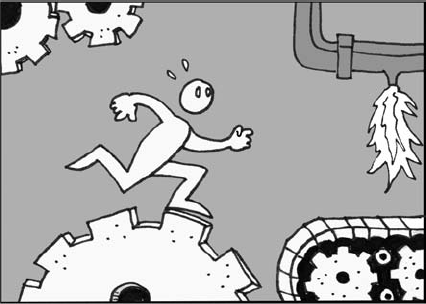
Factory. Factory levels became a staple of platform games, especially as the platform game genre exploded on home gaming systems. The dynamic mechanics offer game developers easily created, combined, and repurposed hazards that can be tuned to a wide variety of difficulty levels. These adaptable factory mechanics quickly spread to other locations too: moving platforms, conveyer belts, and turning gears were present in the tombs, circuses, and space stations of just about every action and platform game[103].

Jungle. The jungle theme allows video game designers the flexibility of the dungeon but without the dull colors and right angles. With its exotic traps (like quicksand and pongee knife-lined pits) and exotic creatures (such as crocodiles, snakes and scorpions) set in a colorful outdoor environment, jungle levels quickly became a prevalent video game level theme as game art became a focus. Jungle levels lend themselves to robust mechanics: swinging vines, tree branch platforms from which to leap, and rivers with moving logs à la Frogger that keep a player's heart beating like a jungle drum.
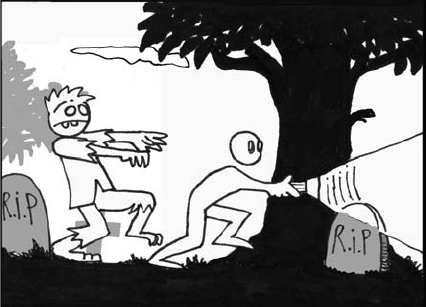
Spooky/haunted house/graveyard. Spooky environments are great when your game requires mood and story. Players slowly explore creepy environments, punctuated by unsuspected "scares" in the form of play mechanics or enemies that seemingly spring out of nowhere. But scaring people is an art; you must build pacing into your levels.
Allow moments of quiet, followed by moments of distraction, before you scare your player. Music and sound design are critical to the spooky theme; it goes hand-in-hand with encounter and puzzle design. But be careful you don't tip your hand too much. You can easily give away your scares if you don't choreograph things correctly. After years of making haunted houses in my garage, I find the best scare is one the player expects but doesn't know where it's coming from.
The spooky theme is also the most adaptable theme of the video game tropes. There have been spooky adventures, platformers, RPGs, FPSs, and even puzzle games. Everything's more fun when it's scary!
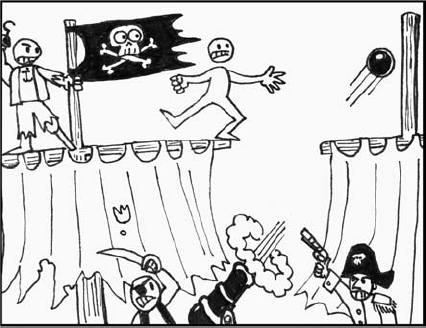
Pirate (ship/town/island). The spiritual brother to the spooky level is the pirate level[104]. The pirate theme is perfect for high action gameplay, melee combat and of course, lots and lots of treasure. Many pirate levels capitalize on the pirate's natural form of transportation: the pirate ship. And then there are the pirate skeletons. Who doesn't love these guys? Like the spooky theme, the pirate theme is treated as a "catch all" that can be applied to almost any genre of game to increase its sales.
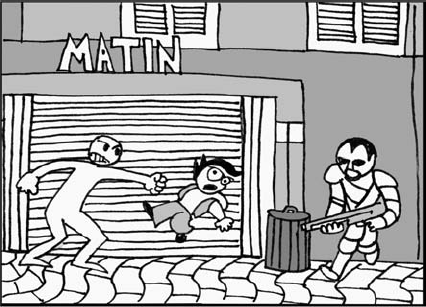
Gritty urban. No matter if it's populated by criminals, punks, mutants or supervillains, the gritty urban theme allows for fantastic action in a realistic and relatable setting. That relatability is part of the genre's appeal. Artistically, it's easier for artists to create the world outside their door. Densely detailed environments just keep looking better and better as system processors and game polygon counts rise. While it's ironic that players would want to play in a world that mirrors the one right outside their door, they get a choice that most people never do: to improve or destroy it.
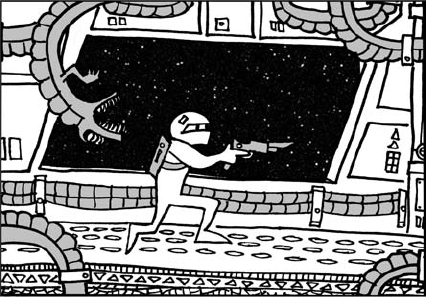
Space station. The space station has become the stand-in for the dungeon in sci-fi games (especially in the FPS and survival horror genres), all strongly influenced by the 1986 film Aliens. In video games, most space station halls are infested with horrible aliens and malfunctioning robots. The space station theme lends itself to a variety of tech-based mechanics including laser-based force fields and factory-style moving platforms. Space stations allow the art team to show off when creating spectacular visual effects, whether it is holographic computer displays or stunning starscapes.
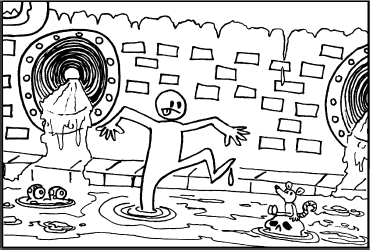
Sewer. While you could eat off the floor of Mario Bros.'s sewer, video game sewers got more disgusting as game graphics improved. This modern analog for the fantasy dungeon[105] grew more complex and deadly with hazards ranging from giant rats and albino alligators to fetid water that caused instant death upon immersion. You can also find the harmonious addition of factory-level mechanics in sewers, such as whirling ventilation fans and sinking platforms to challenge players. Just be glad that smell-o-vision never caught on.
Just because the above themes are considered clichés it doesn't mean that they are unusable. To give them a twist, just apply the Mexican pizza technique.
Back in the 1990s Taco Bell introduced the "Mexican pizza": a pizza-shaped snack made with Mexican food fixings. To me, it sounded vaguely disgusting. However, curiosity got the better of me and I tried it. It wasn't bad. But what I learned was that you can combine two things you wouldn't think go together to get something surprisingly good and, more importantly, completely original.
While designing Maximo: Ghosts to Glory, we applied the Mexican pizza technique. Instead of just a graveyard, our graveyard was cracked apart by volcanic eruptions that blasted out gouts of fire. A fire graveyard, if you will. We also made a pirate level that was enshrouded in ice—you get the idea. We took hoary level themes and breathed new life into them simply by combining them with each other.
Now that you have your level's theme, give it a name. However, a level always has two names: one for the programming team and one for the player. The level name is a file name, created to be referenced with the game's code. Here are a few things to remember when creating file names:
Keep it to eight characters max as (a) it's easy for team members to remember and (b) takes up less space in the code.
File names aren't the name that the player sees, so you don't have to be witty. For example, "factory 01" succinctly lets your team members know the most important info: location and order.
For more complex titles, use abbreviated text: for example, fac01s01 would stand for "factory 1, section 01."
Make sure your naming conventions don't overlap. If "sec" stands for section in one area, don't use it for "secret" in another.
Organize your levels. Keep files in folders where it is easy for other team members to find them. Use file-sharing software to make sure changes aren't made without the other team members knowing about them.
In the context of the game, the level's name is a different matter. Just like with naming characters it's important to give your level the right name: one that fits its feel. There are a few schools of thought to naming levels:
Functional. A straight-up number system is a hallmark of retro gaming. It cuts to the chase and gives the player an idea of progress. However, as most players aren't exposed to the highest number in advance there's no way for them to accurately track overall progress. Another disadvantage to functional naming is that it lacks personality.
Location. Police station. Sewer. Science lab. What's good about using the location names is that you immediately get an idea of what the player will be seeing and/or encountering. However, these expectations are based on the player's knowledge: something that may not match what you are going for. Using the right words is important when naming a location.
Descriptive. "A nasty surprise", "on the road again", "death from above." Descriptive level names read more like chapters of a book. This is great for providing foreshadowing or tone. Be careful not to tip your hand too much and ruin any surprises your plot or level may hold. Or you can be tricksy like the Dead Space designers and have the first word in every level spell out a secret message!
Punny. If you are feeling particularly creative, then try writing a punny title for your game level. Punny titles were all the rage in the late 1990s, starting with Crash Bandicoot. Usually you want to reserve this type of naming for games with a sense of humor.
Remember, level names are your level's first impression so put your best foot forward!
The world is the best narrator.
Ken Levine[106]
I believe that it is within a game's level where the story should actually be told. Using space to tell a story isn't a new concept; it's been used in architectural design for centuries. When I first started designing game levels, I found that theme parks held the answers to many of my questions on how to tell a story as well as inform the player. I pored over theme park maps[107] and studied how they were laid out. I found that theme parks are designed to move guests from one adventure to the next in the most effective way possible, much like a well-designed game level.
Disneyland, in particular, proved to be a source of great inspiration. I read about Walt Disney's imagineers and how they went about designing their own world. Walt Disney had a deep love of miniature railroads and Disneyland was structured around a train track. The imagineers needed something to fill in the middle of the track, so five "lands" were created, each inspired by Disney's passions: history, progress, nature, his animated movies, and nostalgia for his childhood hometown. These became Frontierland, Tomorrowland, Adventureland, Fantasyland, and Main Street.
The imagineers filled these lands with attractions; themed adventures that allowed guests to "ride the Disney movies." These attractions were built as storytelling experiences within a physical space, and detailed attention was given to each scene as the guest passed through it.
I noticed that the creation and structure of Disneyland bore a strong resemblance to creating and structuring a video game world. The basic progression of creation is this:
- Disneyland:
world to land to attraction to scene.
- Video game:
world to level to experience to moment-to-moment gameplay.
The world of Disneyland contains many lands. Within each themed land are attractions, each with their own story. The "story" of the attraction is composed of scenes.
The world of the video game contains many levels, each with their own part of the story. Within each themed level are experiences to move the player through the level. Connecting these experiences is the moment-to-moment gameplay which keeps the player engaged.
This notion of working from the "top down" helped me approach a game world and determine what the confines are and what lives within it; to determine that, you need to make a game world map.
Some designers really got into creating their world map and loved to share it with the player. A common pack-in with early computer games were lovingly rendered maps printed on parchment, cloth, and even faux leather. But you don't need to create anything so fancy. Your world map can be something as simple as a flow chart created in Visio. It only needs to chart out where the player is going and what he'll find there. A map can also define the spatial relationships of locations in the world: this can help the designer determine how the player is going to get around and in what order.
The game world map is important not only to help your team understand the connection of all the levels to one another, but offers the player several advantages as well.
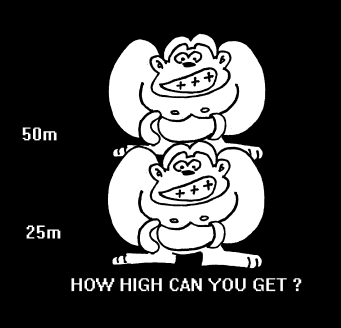
One of the earliest arcade games to expose the player to a map of sorts was Donkey Kong. It was a simple graphic of several Donkey Kongs stacked on top of one another with the challenge "how high can you get?" Challenging the player and letting them know ahead of time how many levels they have to climb in order to win the game whets the player's appetite. It gives them a goal to work toward.

The next great advance in mapping came with the arcade game Ghosts 'n' Goblins. Before starting play, a map was displayed with a little icon of the player at his current location. "You are here." The camera then panned over the entire world, teasing the player with everything that was to come. I remember seeing this and thinking "I wonder what's in that ice level at the far end of the map?"
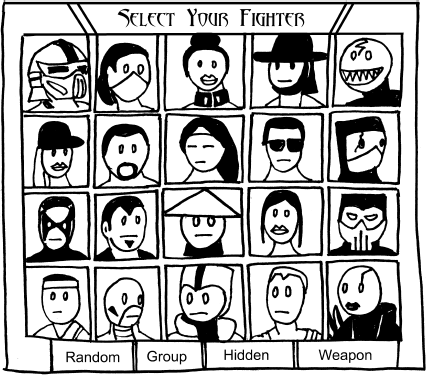
Even if your characters don't physically travel anywhere in your game, you can still use a map to show progression. The fighting game Mortal Kombat displays a screen full of characters' headshots, with most of them "locked up" at the beginning of the game. But by showing all the locked windows, the game's map provides foreshadowing that there will be many characters that the player will eventually fight. As more opponents are unlocked, the player is then compelled to "collect them all."
Foreshadowing is a powerful tool to get a player excited about the activities and dangers found in a level. Building anticipation is just as important as delivering on it. In all my years of making haunted houses, I've found that a scare is bigger and better if the victim knows it's coming. It's waiting for the scare to happen that drives them nuts.
You can use lighting, sound effects, and geometry to make a level look foreboding. And remember, nothing says "beware" like skulls and skeletons strewn around an environment. You can never have too many skeletons[108].
Another lesson I learned from Disneyland is to provide foreshadowing with posters. The guest passes by posters advertising attractions as they enter the park. While the guests don't understand the significance of the images they're seeing, the posters provide foreshadowing to future adventures. In games, one of the best use of posters is in Bioshock when the player, first entering Rapture, sees posters advertising the superpower-giving plasmids. Only once the player learns about plasmids and what they can do, is their significance understood.
Much like a game map, the level itself should help transport the player through the level from story point to story point. The always eloquent imagineers of Disneyland describe it this way:
When we began designing Disneyland, we looked at it just as we do a motion picture. We had to tell a story, or in this case, a series of stories. In filmmaking, we develop a logical flow of events or scenes that will take our audience from point to point through a story. If I were to 'leapfrog' from Scene One to Scene Three, leaving out Scene Two, it would be like sending the entire audience out to the lobby for popcorn in the middle of the film[109].
Disneyland's attractions tell four different stories to their guests. I have found these stories have parallels with the player's goals within a video game level:
Escape/survive
Explore
Educate
Moral.
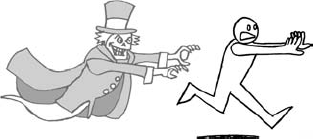
With the escape/survive goal the player has to survive being in a place they have no business being in; whether it's a ghost-infested manor or a crazy factory where one misstep means being ground up into cat food. Storytelling is shown through action and location which moves the player along quickly, using gameplay centered on movement and combat.
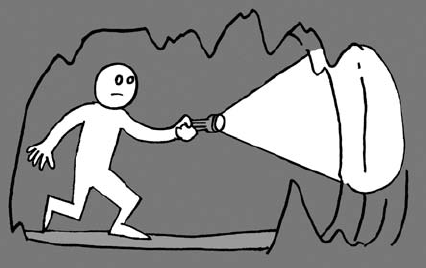
The explore goal allows the player to discover the story at their own pace. The island village in The Legend of Zelda: The Wind Waker and city of Megaton in Fallout 3 let the player explore the environment and create the story in their own order. Freedom of mobility and conversation are important storytelling tools when exploring is the player's goal.
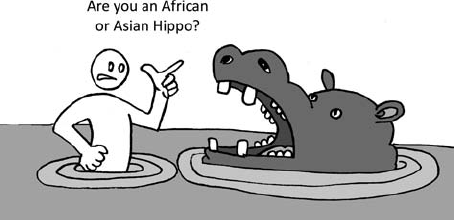
While there are many educational games, the educate goal has yet to make the full transition into entertainment games. Educational games carry a stigma that they are only for younger or "non-gamer" audiences. There are exceptions. Assassin's Creed 2 exposes players to the history and characters of the Italian Renaissance. The developers of Guitar Hero promise their next title will teach players how to actually play a real guitar. Emphasize observation and imitation when determining the player's goals and gameplay.
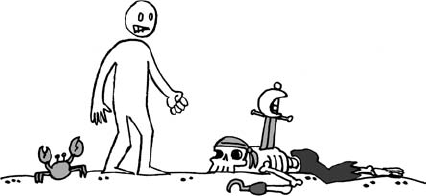
Examples of a moral goal can be found in many of Disneyland's attractions. Mr. Toad's Wild Ride's moral message is: "drive like an idiot and you'll crash and go to hell." Quite a statement for the happiest place on Earth! Games like Star Wars: the Force Unleashed and Fable 2 that allow the player to experience a "good" or "bad" endings have been around for a while, but such moral cause-and-effect rarely exists within the game's levels. Well, except for Bioshock. An early level is a horror show that warns the player of the dangers of using plasmids; ironically, the very thing you are injecting into yourself to give you superpowers. Use choice and consequence to deliver your level's moral goal and then make those choices impact gameplay.
In addition to these goals you need to ask "what is the player's objective in this level?" Some levels exist to teach a specific gameplay move such as jumping, combat, driving, or how to play the game. Answering this question will guide and focus how you design the player's moment-to-moment gameplay within the level.
Now look at all the useful tools you have to help you: character, character actions, story, level themes, a world map. These are all you need to build an entire universe! In order to help organize my thoughts, I like to create a beat chart. A beat chart is a tool often used by Hollywood writers and directors to help organize and plan their movie's production. At the very least, your beat chart should contain the following information:
Level name
File name
Player's objective
Story beat
Play style
Enemies
Mechanics
NPCs
Bonus materials
Time of day
Color mapping
Creating a beat chart helps the designer determine gaps and clumping in your game. You can reorganize the game elements to spread things out and make the game feel more organic. Let's pretend we are making a game called Relic Raider. Our hero, Jake Hunter, travels the globe looking for lost treasure. We've developed our story and have brainstormed the gameplay and the game's environments and enemies.
Take a look at this sample beat chart and see if you spot any problems:
Relic Raider beat chart
Game Element | Level Name/File Name | ||||
|---|---|---|---|---|---|
Shanghai/Roof01 | Jungle 01/Jung01 | Jungle 02/Jung02 | Temple of the hidden skulls/Jung03 | Mountain Escape!/Road01 | |
Location | Shanghai rooftops | Jungle | Jungle | Ancient temple (int) | Mountain pass |
Gameplay | Stealth, shooting, jumping | Shooting | Fighting | Platform, jumping | Driving |
Objective | Find crimeboss Wu-Fan | Jungle part 1 | Jungle part 2 | Reach chamber of skulls | Car chase |
Story beat | Jake steals medallion, is caught by Wu-Fan | Jake explores jungle | Jake finds temple of skulls | Jake places medallion in statue, Nazi general Hauser shows up | Jake steals truck, flees Nazis |
New weapon | .45, machine gun | Machete | No | No | No |
Enemies | Tong thug, axe man, machine gunner | Jaguar, native (spear) | Jaguar | Jaguar, Nazi soldier | Nazi truck, Jeep w/machine gun |
Mechanics | Swinging rope, zip line | Swinging rope, zip line | Zip line | Spiked pits, blow darts, crushing walls, fall-away floor | Falling rocks |
NPC | Wu-Fan | Guide | None | Hauser | None |
Bonus materials | Art gallery 1 | Art gallery 2 | Art gallery 3 | Alt. costume | Art gallery 4 |
Time of day | Night | Night | Night | Day | Day |
Color mapping | Blue/red | Green/brown | Green/brown | Green/gray | Tan/sky blue |
Did you spot all of the issues the beat chart exposed?
Level naming is inconsistent. Rather than have generic titles like "jungle 01" find a way to give them more descriptive names like "temple of the hidden skulls."
Roof01 and Road01 could be mistaken for each other. Name the Shanghai level "Shang01"; the more distinct, the better.
Since Jung03 doesn't seem like it shares too many assets, I would call it "temp01" to show that it's a different place than the other jungle levels.
Do you need two jungle levels back to back? Perhaps the activities in Jung01 and Jung02 would be better combined to make one improved jungle level?
The driving seems to get introduced a little late in the game. Before that seems to be four "on-foot" levels. Find a way to bring the driving in sooner, or lose a walking level.
While the other levels are very specific, the jungle objectives seem unfocused. Give the player more of a purpose.
Introduction of weapons seems to ramp up quickly and peter out fast. That's a warning sign that you need more interesting things for the player to do and toys for the player to use.
The enemies are clumped up at the beginning of the game. Enemy AI could be repurposed for more effective use. Jungle 02, while listed as a fighting level, doesn't seem to have any enemies that would work well with fighting.
Repurpose mechanics like you would enemies. There are a lot of unique mechanics in the temple that will take time and effort to create. Can any of these be re-used in other ways?
Art galleries are a pretty basic reward. What other bonuses can you give the player rather than just the same thing over and over again?
There are three night levels in a row. Break some of this up with morning, evening, atmospheric effects like rain or snow, and so on. And the interior of a temple is going to be dark, so it doesn't make a difference if it's day.
There's a lot of green in that color map. Make sure that the visuals offer a more diverse palette, otherwise all the levels are going to feel the same.
Just by spending a few hours creating and observing the patterns created by a beat chart, we were able to make significant improvements to production, gameplay and art before we built a single asset!
While looking at the above beat chart, I noticed that there are several different gameplay systems: platforming, shooting, driving, and stealth. These different systems add diversity to a game, but when it comes to creating them they have nothing to do with each other. One of the most important design decisions you can make is how and when to re-use gameplay systems over the course of the game.
If you use a game system less than three times over the course of the game, then it's not worth having. This doesn't mean that you have to have the same gameplay section over and over again—you can be smart with your art assets and repurpose them.
For example, a vehicle system can support a jeep, a hatchback, and a sedan. Creating the vehicle system costs more time and money than it does to build the three different cars. But remember, there is only so far you can stretch your recycling: the same system we use for our cars can't support a hovercraft or motorcycle. Although they are both ground vehicles, they behave quite differently.
There is always a trade-off between design and programming. Learn the limitations of the game system and craft your game accordingly. Create a small number of gameplay systems that you can re-use over and over again throughout your game. This will maximize your game as well as your schedule and budget. Use the limitations to your advantage. If you need examples, take a look at any game created by the Japanese developer Treasure Co. Ltd (Gunstar Heroes, Dynamite Heady, Ikaruga) who really knows how to milk a small palette of mechanics. When you are creating your beat chart, make sure you don't use the same gameplay systems back to back. Unless your game is specifically a driving game, don't follow a driving level with more driving.
You can work with your artists on how to best re-use art assets as well. Simply re-coloring and re-texturing game items will make them look different from level to level.
THE GARY GYGAX[110] MEMORIAL MAPPING SECTION
There are many ways to start building level maps. The designers of the original Metal Gear built their levels out of Lego blocks. Many developers do rapid level prototyping in 3-D tools like Maya or 3D Studio Max. One designer I know liked to model his levels in clay. Myself, I like a ream of blank paper, a very sharp #2 pencil and an eraser. I like making maps on paper because it reminds me of the good old days of creating Dungeons and Dragon levels.
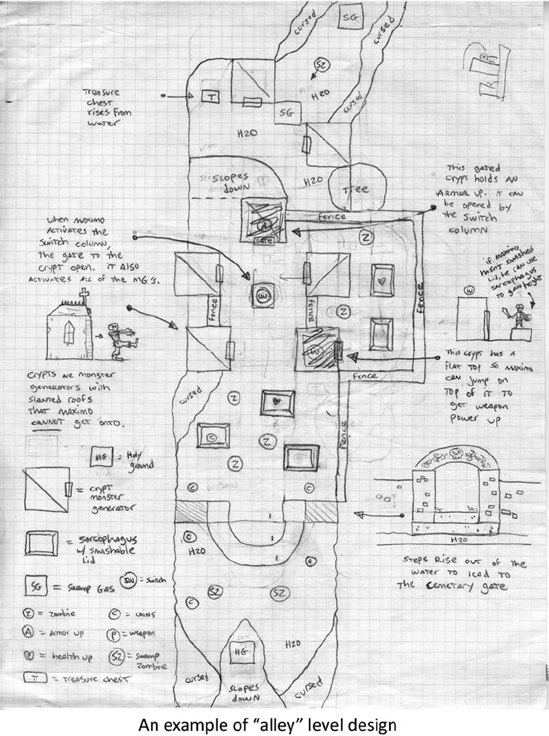
I have found that there are two types of three-dimensional video game level design: alleys and islands.
Alleys create a directed gameplay experience; the player has a goal to reach and the level is built to help them reach it. Your alley can be narrow like those found in Portal or it can be wider to give the illusion of freedom and space, as seen in Call of Duty: Modern Warfare 2.
Alleys offer the following advantages to designers:
It's easier to place camera trigger zones when you know where and how the player will be entering and moving through the level.
You can get dramatic with your camera movements to inform the player, or enhance the action and drama.
You can remove the camera controls from the game, allowing the player to concentrate on gameplay.
You can create scripted, triggered gameplay events, since you know where the player is looking.
It's easier to choreograph combat and other gameplay events like traps.
Bottlenecks can be created to prevent backtracking.
The designer can use illusional narrative to tell the level's story.
The island level, in my opinion, is a bit more challenging to design and build. The game camera has to be flexible enough to accommodate a wide variety of widths and elevations. Scripted events are tough to execute, as there's no guarantee that the player will be looking in the right direction. Combat encounters can be completely circumnavigated by players. Even stagecraft-style tricks like façades are useless, as level geometry can be viewed and interacted with from all directions.
Despite these limitations, island level design offers expansive space that allows the player the freedom to choose the order in which they want to experience the gameplay. Mario 64 is one of the earliest examples of island level design in which the player could choose to climb mountains, explore hills, or swim into underwater grottos in any order they liked. Islands allow for unparallel freedom for the player. In fact, an entire genre—the sandbox—emerged as island level designs have grown bigger and bigger. Grand Theft Auto 4, Burnout Paradise, and Halo's multiplayer levels are just huge island playgrounds.
When creating these sandbox worlds, you should divide them up into distinct areas to aid the player's navigation and orientation, much like the "lands" of Disneyland. Disneyland goes through great pains to make each land visually distinct. Take Frontierland: It has everything you would expect in the old west; watering troughs, wooden cigar-store Indians, wagons, cactus, and even those old video game standbys: crates and barrels. (Frontierland's main thoroughfare was originally dirt road until guests complained about dusty pants and shoes.) Disneyland even themes the trashcans! For example, Frontierland's trashcans are painted to look like wood, while Tomorrowland's are futuristic silver. You always know where you are even when throwing out the trash.
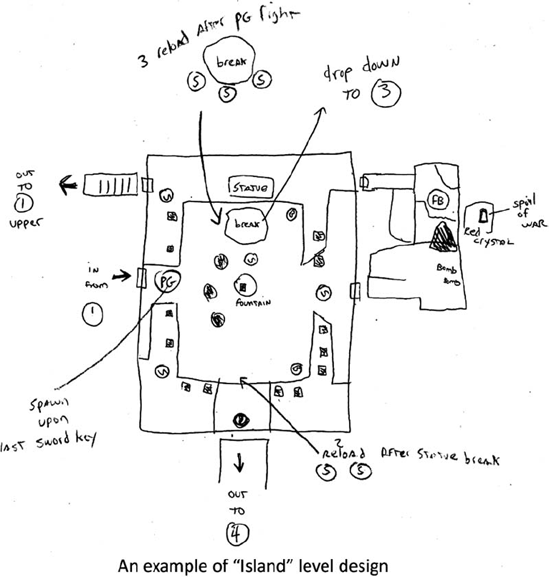
The game Crackdown uses this technique throughout their sandbox world of Pacific City. Not only is each zone themed to aid navigation, but the themes match the criminal gang that the player has to overthrow. The Shai-Gen Corporation runs Chinatown while the tech-using Volk inhabit gleaming skyscrapers.

Disneyland's imagineers pioneered these types of architectural landmarks like Sleeping Beauty's castle, the Matterhorn and Space Mountain, which they call weenies[111]. Weenies are used to get the interest of guests and draw them in their direction. Weenies don't have to be giant castles or mountains. They can be interesting architectural elements like statues, bridges and buildings, or even natural elements like a distinct tree or rock. Theoretically, you want to string your weenies along your path to keep the player moving from one to the next. When creating 3-D maps, make sure the path is clearly marked with weenies. I once created a map that looked like this:
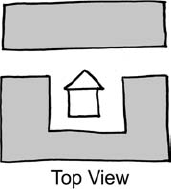
When I play tested this part of the level, players would travel down the road, see the path leading behind the house, and walk around the back of the house looking for treasure. When they emerged onto the road, they turned around and walked back down the way they came!
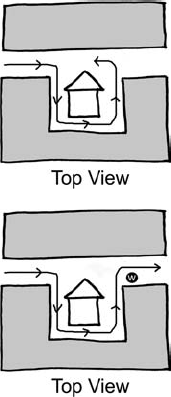
I realized that the area needed a landmark (marked on the map) so when the player came out they were able to re-orient themselves.
This brings up to an important truth about designing games: the player will ALWAYS find a way to break your game, whether they are doing it intentionally or not. Tackle this head-on by making the player play the game the way YOU want it to be played, but provide plenty of help to show them the way.
Islands work particularly well for multiplayer games as you can accommodate many different styles of playing. Do you like to sneak around the back of the map? Islands provide a back to sneak around. You can still charge up the front if you want, or you can camp over on that hill and snipe to your heart's content[112].
But like ebony and ivory, alleys and islands can live together in perfect harmony. Islands can still have alley-like sections. Red Faction Guerrilla and Team Fortress 2 have interior spaces that feel like alley level designs, but their freedom of approach and wide perimeter edges mark them as islands. Uncharted 2: Among Thieves alternates between using alleys and islands frequently. Darksiders and the Maximo games use alleys for their dungeon levels and islands for their hubs and battle arenas. Whether to use island or alley all depends on the gameplay.
Islands have the following advantages:
They give an extraordinary feeling of space and scale. It's quite an experience the first time you realize a level goes on and on.
Islands promote exploration, and encourage designers to fill in "in-between spaces" with secrets, additional missions, and objectives.
Gameplay options are laid out in front of the player like a smorgasbord.
Vehicle gameplay (like racing and car combat) feels better in wide-open spaces than in tight alleys.
Sandboxes are tricky things because I have found that no matter what a player tells you, a world where the player can choose to do anything at anytime can be intimidating and confusing. Despite the freedom that the sandbox world promises the player, they should still get some prompting on what to do next even if they don't want to do it. There's a reason why your annoying cousin is always calling you in Grand Theft Auto 4.
Let's get cracking and get our game design down on paper with a map.
When creating a map, you first must determine a scale. When drawing a top-down view map on graph paper, the size of the player usually equals one square. All other elements, such as treasure, mechanics, enemies or objects, are drawn in relation to the size of the player—much like how you determine player metrics. Represent these elements as icons on your map. Create a legend for the icons on your map so readers can determine what they are looking at. You will want to include:
Player's starting point
Enemy starting locations
Doors, teleporters, gates
Puzzle mechanics (like levers and switches)
Treasure chests and power-ups
Traps, and their areas of effect
Significant landmarks (like statues, pools, pits, and so on).
I start my level map creation process by roughing out the major locations where I want big events to happen: a treasure chamber, a battle arena, a puzzle room, a mechanic that you want the player to learn, a spectacular view, and so on. Then I start to think about what I can use to connect those rooms together: hallways, mazes, chasms, or passages. Then I usually move on to graph paper, which helps me communicate the scale of the level to the level artist. Often I will draw in elements such as the tombstones, crypts, mechanics, and enemies.
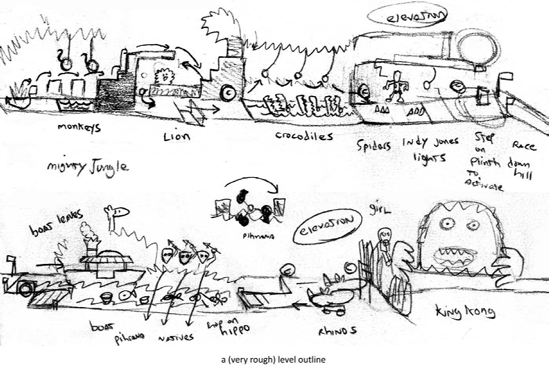
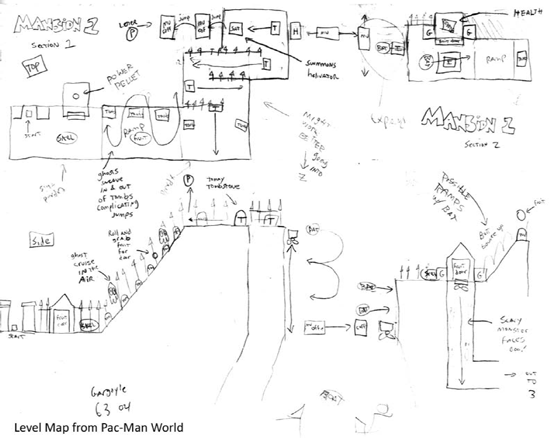
When creating passages for a top-down view map for a 3-D level, I recommend making it five squares wide: that's the width of the player plus two more widths on either side. It provides enough room for the player to navigate, for combat to occur, and the camera to have some room to maneuver. However, I can guarantee that your first few efforts at level design will usually end up too small and too cramped, so don't be afraid to be generous with your proportions.
Use geometry and lighting to help move the player down the path. Players are drawn towards light, while they tend to avoid or overlook dark places. You can use shapes like diagonal lines to draw the player's eye in a specific direction. I learned my favorite trick from the designers at Naughty Dog, the creators of the Crash Bandicoot and Uncharted games. They use a trick they call the squint test. Take a look at the image below and squint your eyes until they are almost closed.

What's the brightest thing on the screen? The main path. You can do the same thing in your game using color and lighting. Even if the player doesn't consciously notice this, they will still be able to see which way to go. If the player has someplace to go, don't waste their time with needless wandering. Never intentionally try to get the player lost. Instead, find ways for them to get quickly to the main objective. A good trick is to talk your way through a level design. Describe to someone else what the player will be doing. If you ever find yourself saying "then the player walks over to here", cut that section out of your game. Because a very important thing is:
Only lazy designers consider walking to be gameplay. You're not a lazy designer, are you? Of course you aren't. You are an active designer. An active designer who creates active things for your active character to do. Actively.
Prevent the player from walking for too long. Look at all the other things the player could be doing instead of walking.
Jumping
Fighting
Collecting
Climbing
Swimming
Swinging
Flying
Escaping
Sneaking
Exploring
Speaking of exploring, let's talk about multiple paths. Which one to take? The one that leads to the harem of 1000 delights or the one that leads to the lava pits of Overfiend? Decisions, decisions.
No matter how you slice it, multiple paths are a tricky thing to deal with, regardless of whether you are designing an alley or an island. They work better for some genres of games than others. The wide-open worlds found in FPSs, RPGs, and driving games require multiple paths just to keep traversal from getting boring.
But multiple paths raise multiple questions that need to be addressed: Which path will the player choose? What can you do to entice a player to go down one path over another? What can the designer do to promote the player to use that alternate path? Hidden power-ups or cash prizes? Provide an achievement for all secrets discovered? Some producers balk at the idea of designing and building a part of the level that the player may never see. Whatever the answer you decide on, make sure that it provides something significant to your level.
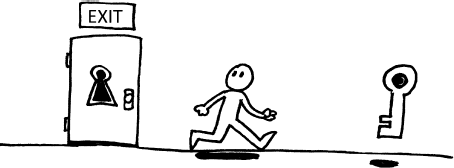
Some designers don't like backtracking, when a player has to go back to a part of the level they've already been to. I don't mind it. I think it's a good way to get the most out of your level. I like to use backtracking for puzzles. I always say "show the player the door first and then let them find the key." Just don't make the player go back and forth too many times. If you need to make the player go to a location more than twice, do something to it to make it different: add gameplay like (new) combat or collectibles, change the topography by having an earthquake change a flat spot into jumpable hills. A nice natural (or unnatural) disaster can work wonders.
Conversely, you should design alternate ways for your player to get around your level and game world. These are unlocked as the player exposes more of the world. Anything is preferable to having to plod through the same terrain over and over again. Give the player a car or a horse to get through those slow spots, let them ride a train or get a lift in a zeppelin, or, if your fiction supports it, there's always the ever-popular teleporter.
Just be aware that traveling in vehicles can really chew up the real estate. You'll want to build that space into your levels. But it's a double-edged sword. Don't make the experience last too long, especially if it's something you will be doing often. Just remember the very important thing when it comes to traveling through levels:
Avoid boring levels! But how? Variety is one way. Fingers are another way of making a world feel deeper and fuller without having to build lots of complex geometry and multiple paths that the player may never take. Picture a linear path.
Not too exciting, huh? You can place all type of hazards and enemies along the way to make things challenging for the player, but it's just going to feel like a straight path even if you crinkle it up and bend it around.
However, if you start to add fingers off of your path, little dead ends for the player to explore and go down, it makes the player feel like they are exploring the level and not just promenading down it. It expands the life of your level and you can promote the player exploring it. Let's take a look at our level now that we've added a few fingers off of the main path:
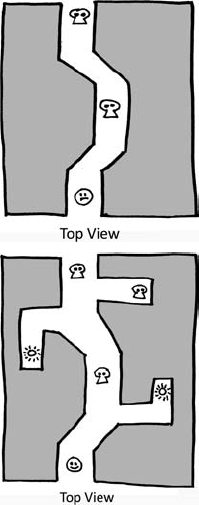
Now you have interesting places for the player to explore as they work their way through a level. While I wouldn't suggest putting something down a finger that is important to the critical path, you can place whatever you want down a finger: combat, treasure, bonus materials, or just something visual or fun. Remember this simple yet very important thing:
EVERY FINGER SHOULD HAVE A REWARD AT THE END, EVEN IF IT'S JUST A TRASHCAN[113]
Creating elevations on a top-down view map can be a bit tricky. You can draw levels in different colors, but I find that gets visually crowded. Use tracing paper or paper and a light board to layer the elevations of your level, and break them up by the height of the player. Be sure to clearly mark which elevations are what so viewers can read them in the correct order. While you are at it, number the consecutive map pages or tape them together into one big map so they are easier to read. Just because a sheet of paper is square doesn't mean you have to design to a square shape. Cut, fold, extend—do whatever you have to do to make your map accurately represent your design.
If you are drawing your map from the side view, determine the height of your character first and then draw the map to scale. It's a lot easier to show vertical gameplay from a side view. Sometimes you are going to need a combination of side and top view maps.
You don't need to be working on a game with an isometric camera to use an isometric map. They're a little trickier to draw, and they require some artistic skill to create, but they work great for showing things like elevation.
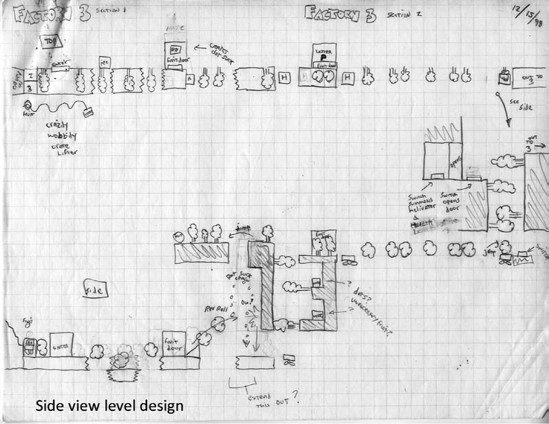
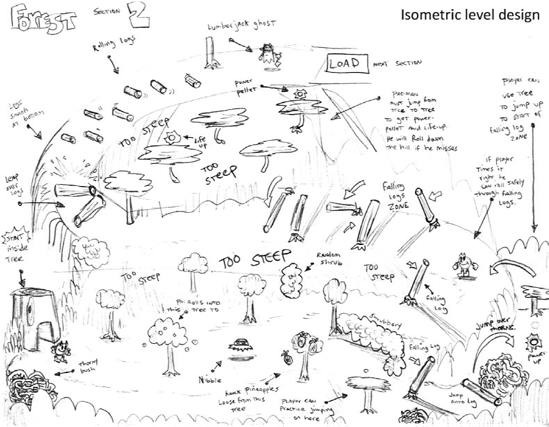
Isometric maps work best when representing games using a 2.5-D camera. If you need to show depth or a part of the level that is obscured by geometry on your map, you can show the missing information using a cutaway or X-ray view. Or you can create a flap that can be lifted by the viewer to see what lies underneath. Make as many layers as you need to convey your idea for your level. Some of my levels have had so many panels, they started to look like an advent calendar!
Other information to include on your level design maps:
Enemy spawn locations and detection/aggro radius.
"Bread crumb" collectibles (like coins or Pac-Man dots) that lead the player through the level.
Secret entrances/breakable walls or other concealed locations.
Obstacles and barriers like walls, trees, tombstones, and so on.
Be sure to clearly mark specific terrain like cursed earth, swampy water, slippery ice, and hot lava.
Illusional narrative is a storytelling trick I first observed when riding the Peter Pan's Flight attraction at Disneyland. Having flown over London and to Never-Land, we have reached the part where Peter Pan and Captain Hook are engaged in a pitched sword duel on the deck of the pirate ship. The Darling children have been captured by the pirate crew and watch the battle.
The guest's ship flies around a corner (cleverly disguised as the sail of the pirate ship) and now. Peter Pan is victorious, the Darlings are freed, and Captain Hook is keeping himself from being eaten by the crocodile.
Illusional narrative is the video game equivalent of what happens in the gutter of comic book panels or between edits in a movie: the player fills in story when given two or more images or environments. With the proper transition and presentation, you could convince a player that a train has crashed, a world has become overrun by aliens, or a character has crossed a room without animating a single element. The cost to production is significant. Real-time animations take time to produce and have to be ripped up and redone if the designer decides to change something in the level.
Just make sure that the elements are viewed in the order of your story, and use gating mechanisms such as bottlenecks, camera views, checkpoints, turning elements on and off, or even plain ol' doors to keep the player from "turning back the page."
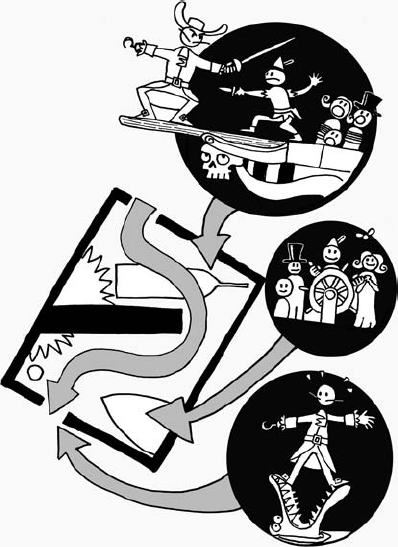
Armed with your level maps, you are now ready to start building (or have an artist start building) your game levels. But hold on there, tiger! Before you even start thinking about enemies, mechanics or even detailed geometry, you will have to flesh out your level in gray box form.
A gray box level is created within an art tool (Maya and 3D Studio Max are the two most common industry art tools, though others exist). The gray box level shows the scale, size, and relationship of basic elements pertaining to camera and character metrics. It is pivotal in determining scale, camera, and pacing. Spend time running your game character around the gray box level. Have others play the level to find confusing areas and trouble spots. Iterate on your level while it's still easy to make big sweeping changes. You may find that a level works better if you rip out an entire section and stitch the remaining pieces together. A straight hallway may be more thrilling with plenty of twists and turns to transform "boring old" enemies, mechanics, and treasure into unexpected surprises.

As you are building your level, you might be wondering how long should a level be? Early in the production process, you should pace out a level to determine its overall length. Start your character at the beginning of your gray box level, then start walking. Don't worry about hazards or combat or collecting every music note in the level. Just walk from the start to the finish. Whatever time it took for you to get from point A to point B is roughly half the time it will take you in the final game. So if you need your levels to average a half-hour each, then it should take 15 minutes to pace out the level. While it seems weird to do this, remember that many publishers and reviewers are concerned with the overall length of a game. I tell developers that a single-player action game should last at least 8 to 10 hours. Going longer than that is great; just make sure your production schedule and team plans for it.
Another pacing technique is to change the player's emotion every 15 to 20 minutes. Sadly, the gamut of emotions experienced in most video games is pretty limited[114], but you can make a player go from mystery to fear to panic to wonder using geometry alone.

Divide your gameplay between "big moments" and "small moments." Don't stack too many big moments next to each other—you'll wear your player out. Conversely, small moments of calm and quiet will only feel boring if there are too many of them in a row. Shadow of the Colossus successfully balances the big moments of battling giant monsters and quiet moments of traveling through the expansive game world.
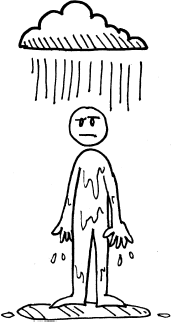
Time of day and weather can be used to emphasize events and elements in your level. How would the player traverse the level if it were covered in snow or took place during a blizzard? How would a fairy village look differently if it were set at night? Make sure that any weather effects extend to the player character, the mechanics, the enemies, and other elements in the level. If one element isn't affected by the weather, it will ruin the entire effect. Give your game levels a variety of atmospheric effects and times of day to keep things interesting.

Variety should be applied to the level geometry as well as to gameplay. Alternating interior and exterior spaces keeps your level from feeling like too much of the same physical space. You don't have to alternate the spaces in between every room but break it up according to what feels natural. Players usually feel safer in large spaces. Tighter spaces feel more mysterious and dangerous. Be mindful of your camera placement throughout your level design. Allow enough room in tight spaces for the player and camera to move around or just resort to a fixed or rail camera. When staging combat, larger spaces allow you to throw bigger and larger groups of bad guys in, while narrower spaces work better for one-on-one battles.
Verticality is very important when designing levels. Alternating elevation makes an environment feel natural, provides much-needed variety, and allows designers to set up "Kodak moments" of any impressive visuals like statues, vistas, and horizons. As a player walks or climbs up, they feel like they are making progress and heading towards a goal.
However, as a player travels downwards, they may try to skip elevations by jumping downwards. If the player can be killed by very long drops, make sure that the player has a way to look down to gauge the metrics of the drop. There's nothing more annoying than falling to your death if it looks like you can safely make the drop. If you don't want the player to drop down, then corral them in the direction you want them to travel with switchbacks, ladders, or other climbable surfaces.
My golden rule of level design is this very important thing:
Establish a visual language within your level to establish where the player can and cannot go. Use low walls, shrubbery, or rock walls to indicate impassable areas in the level to the player. They will learn that these visual cues mean "you can't go there." Whatever you do, please don't be a lazy designer and use invisible walls.
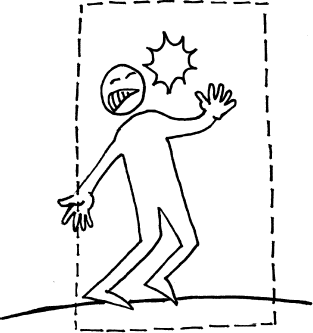
Nothing breaks immersion faster and makes a level feel less like a real place than smacking headlong into a big fat wall of nothing.
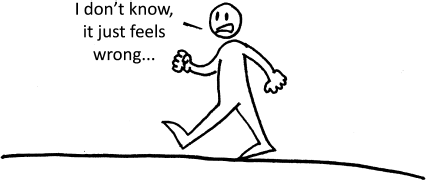
Want to screw with your player's head? Have your character travel from right to left, particularly if you are making a 2-D game. Western audiences are used to reading and viewing information in a left to right orientation. Making a character walk from right to left can make a player feel uneasy, even if they can't articulate why[115]. I find this works best when the character is entering the boss's lair at the end of the game.
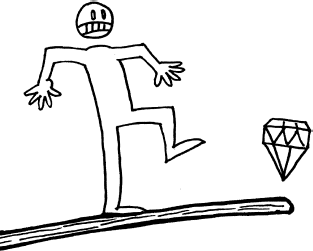
Another fun way to torture your player using level geometry is to force them to walk across very thin platforms over great heights, boiling lava, or swirling whirlpools. Increase the danger by using a bird's-eye view camera to view the action. I call these perilous situations sphincter twitchers, and use them in all of my level designs. Even if the player is never in danger of dying, they sure will feel like they are!

When working with your artist, unless the surface is specifically designed like a ramp, stairs or natural incline, make sure any geometry that the player can stand on (like platforms) is relatively flat. Most characters are not programmed to adjust their body to uneven surfaces and, even if they are, they can "stutter" or misstep as they are playing their walking animations. Try to have smooth transitions between even small elevations to avoid this problem.
While making a level feel like a real place helps the designer create the level, remember that you shouldn't be bound by realism: this is a game after all, and you are only limited by how real you want to make it.
However, here is a cautionary tale about realism. A friend of mine was a designer who joined the team of an action shooter. The levels had already been created by the artists, who were extremely proud that they had created architecturally accurate buildings. These buildings had realistic nooks, stairwells, in-scale hallways, and even bathrooms on each level. The buildings were almost completely unusable in the game as the spaces didn't allow for gameplay or work well with the game camera. Think of it this way: in the movie Star Wars we never saw the toilets on the Death Star. I'm sure they were there just off camera, but because we didn't need to see them, we didn't have to see them. Omit any parts of your building, temple, city, and so on that doesn't help support telling the story that you want to tell.
Stop! Wait, you haven't built your gray box levels yet have you?
Good, because you will want to create a playground first. A playground is a gray box level not intended to be used in the game. It is a separate testing ground for game mechanics and hazards. All mechanics and hazards should be tested and tweaked in the playground until they feel right, then you can use them in your levels. Here are a few things to test in your own playground:
Create ground angles to test basic walking, running, inverse kinematics (IK), and other technology to make sure the player looks good while moving even when not on level ground.
Build several simple boxes at a variety of elevations to test the player's metrics with jumping, hoisting, teeter, etc. You should create any specific length and height geometry to test double and wall jumps.
Test mechanics and hazards to determine distance, timing, and lethality.
The sister to the playground is the combat arena. This is just like a playground but used by the dev team to test combat systems, cover systems, and enemies. Have a way to quickly spawn and test combinations of enemies to create the best combat experiences. I'd rather hold off on talking about this because—SPOILER ALERT—the next two chapters are all about combat and enemies!
The training level is where the player learns all of the basics of gameplay. It teaches the player the game's basics. It is the player's first impression of gameplay. It stokes the player's enthusiasm[116] for the rest of the game. You'd think that this is the most important level of the game.
You'd think!
Unfortunately, the training level is often left until the end of the game's production. Now, I know why this is done. Developers will argue that you won't know the most important lessons of the gameplay until everything is in the game. They state that by the end of the game's production, the art team is capable of creating the best-looking art and effects for the training level in order to give the first level of the game the biggest bang for the buck. Sometimes they claim the player will learn the basics over the course of the game. The reality is, production schedules get tight and priorities shift, resulting in the training level usually not getting the love and attention it deserves.
You may want to consider creating the training level first. Sure, it may not look as pretty, but your team can always go back and polish up the art. The advantage is that you, along with the player, will be learning the basics, and can accurately determine what the player should learn before the designer blinders kick in. A training level always benefits from a pair of fresh eyes.
Even better, don't have a training level at all. I have found that in the best games, the player is always learning new moves, gaining new gear, experiencing new gameplay, and constantly learning. Why not make your entire game the training level?
Now that we've started to create our levels, what are we going to fill them with? I have a sneaking suspicion we'll find out in the next chapter...
Level 9's Universal Truths and Clever Ideas:
Use the "Mexican pizza" technique to make level themes unique.
Level names can help convey mood and info to your player.
Design from the top down: world, level, experience to moment-to-moment gameplay.
You can never have too many skeletons.
Use level maps and posters to give information and build anticipation.
Determine the theme of your levels: escape/survive, explore, educate or moral.
Use the beat chart to point out weaknesses in your game's overall design.
Design your games using a tight set of gameplay systems and mechanics: maximize play through re-use.
The player will always find a way to break your game.
Make the player play the game the way you want it to be played.
Is your level an alley or island? Design to each style's strength.
Map and gray box your levels to plan camera placement, prevent architectural issues and gameplay problems.
Walking is never, ever gameplay.
If it feels too long or too boring, then it is.
Every finger should have a reward at the end, even if it's just a trashcan.
If it looks like the player can go there, then they should.
Use playgrounds and combat arenas to test metrics and systems.
Leave the training level for last (or not).
The entire game should train the player.
[98] Score: (1) To gain something (as in "I scored a battle axe off that weapon drop"), (2) to calculate a total (as when a high score is tallied), (3) to cut without cutting all the way through (like scoring metal with a lightsaber), (4) to "get lucky" with a ... but hey, this isn't a dictionary.
[99] And by beating, I mean punching, stabbing, shooting, karate-chopping, decapitating, rocketing, and exploding.
[100] It can be in any action game, not just ones with "2" at the end of their names.
[101] Remember, these terms were first created and used by early game creators: the same guys that made up your high school rocket club. Sorry cool kids, the nerds have taken over the world.
[102] World 1-1 is grassland, 1-2 is an underground cavern, 1-3 are mountain-like platforms, and 1-4 is the interior of a castle. These levels are all part of a world known as the Mushroom Kingdom. And now you know.
[103] I consider it a triumph of the video game industry that Star Wars creator George Lucas, at the last minute, added a factory level to his 2002 movie Attack of the Clones. The movie's heroes ride conveyer belts and make timed jumps through smashing presses worthy of a sequence right out of a Nintendo platformer.
[104] The only reason I can fathom why pirate and spooky levels are often found in the same game is the designers love for Disneyland where the "Pirates of the Caribbean" and "Haunted Mansion "attractions are found in the parks "world" of New Orleans Square. I know that's the reason why we had them in Pac-Man World.
[105] Didja know that early D&D players would play live-action sessions in sewer and drainage systems? The forerunner to today's live-action roleplaying (or LARPing).
[106] Ken Levine was the creative director of Bioshock, a highly rated FPS whose fully realized undersea world of Rapture has become the gold standard for level design.
[107] I used to love to collect theme park brochures during family road trips to other more educational destinations; souvenirs of places I never actually visited. Who knew they' d come in so useful in the future!
[108] While I believe that you can never have too many skeletons, I think it is possible to go overboard with filth and gore. Some horror games levels are splattered with blood and grime. Maybe it's just me, but I never find these environments scary. What is scary is a befouled bathroom—but what makes it so scary is the smell and that you may have to touch something: two senses that are completely absent from a video gamer's "vocabulary." And by the way, having a room decorated with corpses strung up like Christmas ornaments doesn't make it particularly scary. It just looks...festive.
[109] Disneyland The First Quarter Century, Walt Disney Productions, 1979.
[110] Ernest Gary Gygax (1938–2008) along with David "Dave" Arnenson (1947–2009), created the first role-playing fantasy game, Dungeons and Dragons. Creating dungeons and adventures for D&D served as the springboard for many a young game designer's career, myself included.
[111] Walt Disney himself coined the term after the frankfurter that off-screen animal trainers would wave at their dog actors to get them to walk past the camera to where they wanted them to go.
[112] Not that anyone reading this book would stoop so low as to be a camper. And remember, there is a special place in hell for spawn campers.
[113] Whether that trashcan has trash or treasure in it is up to you.
[114] I would go as far as to say that most video games let the player experience only five emotions: aggression, fear, surprise, joy, and disappointment. And some games only disappoint.
[115] I have no idea if this trick works on Azeri-reading players.
[116] Hey, I think I found a sixth emotion!
